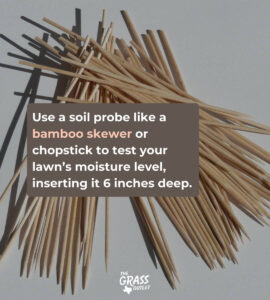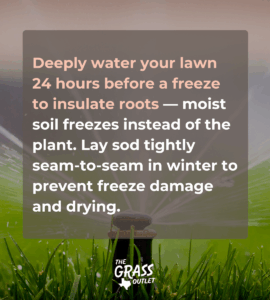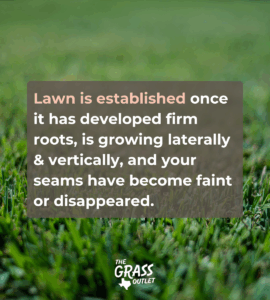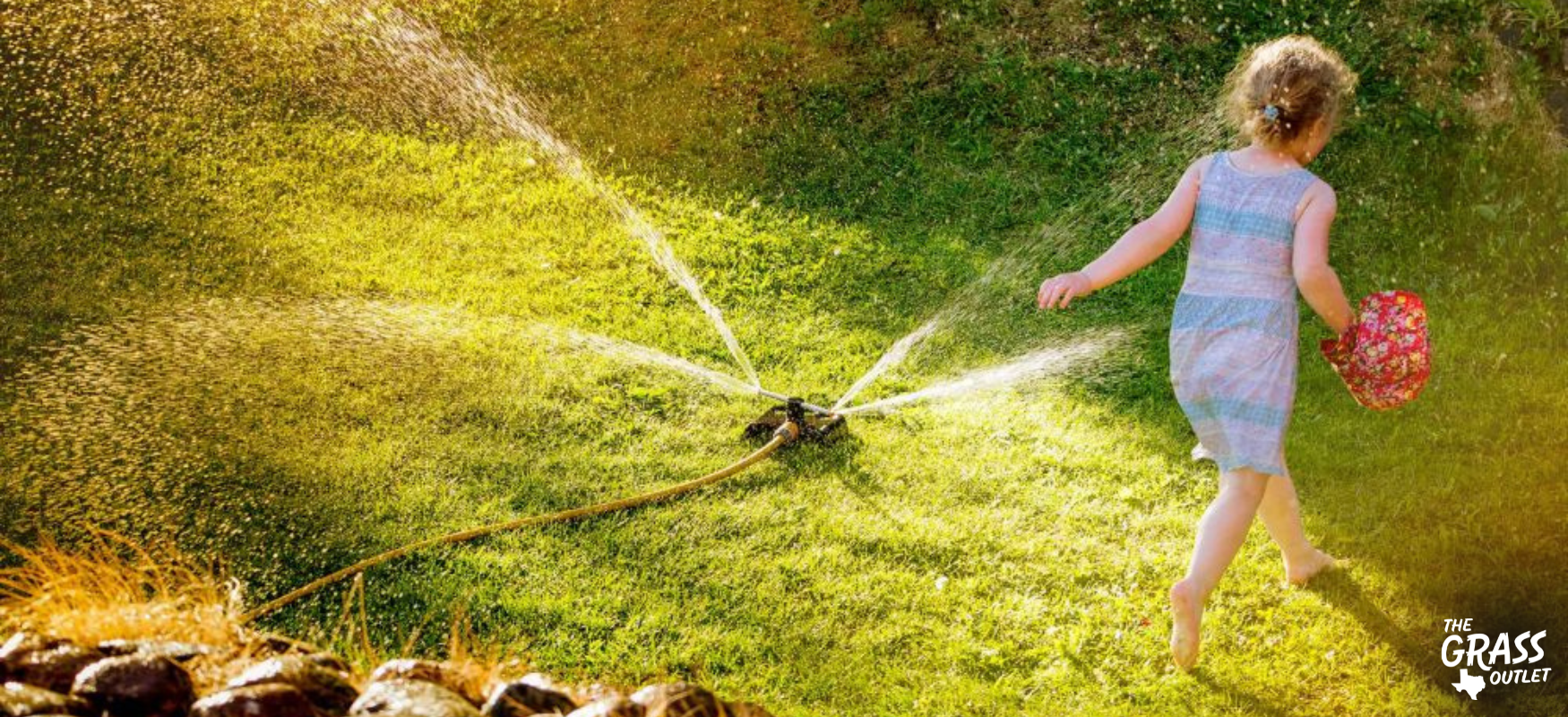Prompt and Weather Appropriate Lawn Irrigation Is Key to Healthy Establishment
When grass is harvested, its root system is severed, and the grass can no longer access water & nutrients from the earth. It is not unusual for the sod to begin to stress and yellow immediately post-harvest. This discoloration will vary post-installation depending on ambient temperatures, sod variety, ground prep, type of soil used, irrigation schedule & method, etc. For example, grass will yellow more and faster during the hottest months, especially with delayed or inadequate water. It is important to note that grass will also be yellow in the late fall/early winter as it transitions into winter dormancy and will remain yellow until soil temperatures stay above 65°F consistently.
Grass is Dependant On Immediate Care
Grass is a living product that relies on prompt installation & proper irrigation to pull out of harvest/transplant shock and establish a healthy root system. Please thoroughly review the information below for instructions, tips, and resources on determining your sprinkler system’s efficiency to ensure your grass receives adequate water.
Be advised that the irrigation schedule/duration will vary depending on many environmental factors, such as, but not limited to:
- Ambient temperatures
- Depth of soil cultivatio
- Soil condition & profile
- Ground compaction
- Grass irrigation method
- Amount of full sun
- Proper installation (no gaps/overlapping)
- Sloping
- Sod variety
- Daily wind speeds
- Irrigation efficiency
- Weather
Grass Irrigation Coverage, Functionality, & Precipitation Rate
You must inspect your grass watering system for efficiency & coverage and confirm your sprinkler heads are working correctly. Please watch Real Green’s Pest & Lawn’s video for instructions on using Aggie Catch-Cans to gauge your lawn irrigation system’s precipitation rate and confirm even coverage. Use this precipitation rate to determine the duration needed to achieve the 1.5 inches of water required daily while the sod greens up and establishes its root system.
Deep Soil Saturation is Critical
When soil is dry, water will percolate laterally before saturating deeply. As a general guideline, you should apply at least 1-1.5 inches of water to each zone at once to saturate the soil to a depth of 6 inches every morning to encourage a healthy, deep root system.
Depending on your soil type, applying the water all at once will allow the water to percolate deeply into the soil, whereas applying the water in shorter cycles & leaving over an hour in between will result in water losses through evaporation. Shallow soil moisture during the establishment period will encourage shallow root development, affecting the health of your sod indefinitely when not promptly corrected.

Simply slide the tool into the soil at the seam (between the blocks) about 6 inches deep, leaving it inserted for one minute. Next, gently/slowly pull it out. You’re good if 1) the tool glides in easily & without resistance 6″ deep using little pressure/force and 2) you observe moisture or dirt sticking to 6″ of the implement. You can also use a soil probe or a long screwdriver (6″+) to ensure deep soil saturation and check your soil composition.
Water Losses Occur Due To:
- Air evaporation
- Soil surface evaporation
- High wind speeds
- Water runoff
- Hotter ambient & soil temperatures
- Tree canopies & roots
- Reflective heat from surrounding concrete, hardscaping, fences, structures, etc.
Converting Inches to Minutes
As discussed in SAWS’ Garden Style newsletter, your actual irrigation application rate depends on your lawn irrigation system’s age, head type, nozzle type, spacing, and pressure. Further, you must consider the six S’s: sprinkler-head type, soil, shade, slope, species, & season. Because these determinants can vary significantly for each individual’s yard, we can’t tell you the exact duration you’ll need to run your system to water your grass appropriately. However, we will do our best to get you on the right track!
For a typical in-ground irrigation system, the average application rate for a standard zone by sprinkler head type is:
- Pop-Up Spray Heads …….. 1.65 inches/hour
- Rotor Heads …………………… 0.75/hour
- Multi-Stream Heads ………. 0.45/hour
So, to apply the 1-1.5 inches of water needed for healthy establishment, the standard runtime is:
- Pop-Up Spray Heads …….. 36-54 minutes per zone
- Rotor Heads …………………… 80-120 minutes per zone
- Multi-Stream Heads ……… 133-200 minutes per zone
Please remember that these run times are going off standard conditions, and you must consider the six S’s mentioned above. For example, if you have dappled shade conditions, your yard might only need about 60% of the typical runtime for your sprinkler head type. e.g., For a pop-up head irrigating grass in the shade, you might only need to run each zone for about 32-33 minutes instead of the 54 minutes the grass planted in direct sunlight needs to achieve an inch & a half.
Adjusting Durations, Extreme Heat, & Supplemental Water
Additionally, keep in mind that grass that is not sod rolled after installation and pieces with gaps will need supplemental water in addition to normal irrigation. During temperatures near or above 100°F, you must monitor your grass closely for drought/ heat stressed lawn areas daily, particularly areas planted in the full sun, along edges, on uncultivated or compacted soil, on slopes, near concrete, etc. Increase your irrigation runtimes accordingly, and apply supplemental water to stressed areas in the late afternoon or early evening in these instances until the grass establishes and recovers.
Watering Slopes
If installing on inclines, please watch this short video below for instructions on using the Cycle-Soak Irrigation Method to avoid runoff water loss and shallow irrigation. Another issue with runoff is that, when observed, it often leads to the incorrect assumption that the lawn has received enough water. This is one of the most common reasons for inadequate irrigation & shallow soil moisture.
Watering Different Soil Types
Loams & silt loams have the most plant-available water because they allow some water & air to be stored in the various pores sizes these soil types contain. We recommend having 6 inches of healthy topsoil with about 50-60% chocolate or sandy loam/silt mix, with 40-50% organic material, such as mushroom compost. At a bare minimum, you should have 2-3 inches depth.
Very sandy soils have mostly large pores that drain too quickly, leaving the pores to fill with mostly air & little to no water. This means sandier soils must be irrigated more often.
Clay soils have mostly tiny pores, which will hold the moisture longer, leaving no room for air, and typically require slower & longer irrigation runtimes to water deep enough. Additionally, because the pores in clay soils are so small & dense, your grass roots cannot use the water. Both usable water & air are essential to healthy root growth.
Be advised that dense clay soils & compacted earth can also cause water losses due to runoff. Heavy clay soils can also keep all the moisture nearer the soil’s surface, preventing the deep saturation needed for healthy, deep root establishment. Please watch the short video to understand better how your soil type & the condition of your soil will impact the efficacy of your irrigation efforts.
Post-Install Green-Up
Depending on your soil, ambient temperatures, weather, and irrigation schedule, your new grass should green back up within the first few weeks with proper water. If you notice your sod declining versus improving over the first three weeks, please reach out to us by submitting a concern as soon as the decline is observed. Please do not wait until the grass has died to contact us with a concern.
Irrigating New Grass During Winter Dormancy
Dormant Grass Will Arrive Yellow or Golden-Brown
It is entirely normal for grass to turn yellow as it transitions into winter dormancy after the first heavy frost or overnight freezing temperatures. Grass delivered in the late fall through early to mid-spring will likely be yellow to some degree. Keep in mind that our farms are open fields located in rural areas. So, sod coming from the farms will be more dormant than sod in suburbs and metro areas where the asphalt, houses/buildings, concrete, trees, etc., keep the soil temperatures warmer.

Deep Grass Waterings Insulate & Protect Roots
It is important to note that most people that lose their grass over the winter lose it due to a lack of moisture. As long as there is proper moisture, the water will freeze instead of the plant. Deeply saturating the soil 24 hours before a freeze will warm the soil and help insulate & protect the root system. When installing sod during winter dormancy, it is essential to avoid gaps by laying the grass blocks as closely together as possible without overlapping. Laying the sod seam to seam will also help protect the grass from freezing temperatures and drying out.
Dormant Grass Requires Less Water
The reduced water requirement is the biggest perk of installing grass during winter dormancy. However, although dormant sod has reduced water requirements, you must keep it wet when installing during the winter. You only need to keep the top 2 inches of soil moist throughout the winter since the sod will not take root as deeply or quickly as it does during the warmer seasons.
Depending on your soil type and weather, you should only need to apply about 0.5-0.75 inches of water every 5-7 days to achieve and maintain this moisture depth. Texas A&M Agrilife’s short video will instruct you to use the Catch-Can Method to gauge your irrigation system’s precipitation rate and confirm Catch-Can Method to gauge your irrigation system’s precipitation rate and ensure even coverage.
Water Adjustments Depending On The Weather
Be advised that if there are frequent stretches of warmer weather and no rainfall, you may need to increase your irrigation to put out about an inch of water per week – Or daily if the grass begins coming out of dormancy. If your sod is not fully dormant, starts to come out of dormancy, or if temperatures consistently stay above 65֯ F, you will need to follow the typical irrigation schedule for newly installed grass.
Excessive Moisture Encourages Lawn Diseases
Additionally, even though water is critical to the sod’s health, you need to be careful not to overwater the sod when temperatures are colder. Irrigate only during the early morning hours before 10 am. Never irrigate during the evening or overnight. Grass watering in the morning will help avoid excessive moisture that tends to lead to fungal lawn disease.
Dormant Grass Establishes & Grows Significantly Slower
Finally, the grass will not grow significantly as it exits its active growing season and begins to transition into dormancy. More than likely, the sod will not fully establish its root system or have noticeable lateral growth when installed in the late fall through early spring. Do not be alarmed if the seams do not fill in until the spring when the grass enters its most active growing season. Be advised that you must apply 1-1.5 inches per zone daily when the grass begins greening in the spring. Continue this irrigation schedule until it fully establishes roots in the soil.
Established Lawn Irrigation
Once your lawn has fully established, you should begin a regular watering schedule. You will know your lawn is established once it has developed firm roots, is growing laterally & vertically, and your seams have become faint or disappeared.

Texas A&M recommends lawn watering deeply & infrequently. Doing so ensures deep soil saturation and conserves water. Typically, warm-season grasses need about 1-1.5 inches of water every 7-14 days, depending on the five S’s mentioned earlier in this article.
Only water when your grass needs it to encourage deep roots, promote optimal drought tolerance, and conserve moisture. You will know your grass needs water when you observe signs of drought stress, such as blade wilting & curling, lasting foot impressions, and dullness/dryness.
Please do not wait until your grass becomes yellow or bronze & crispy to irrigate. Doing so will only require more water to get the grass healthy & green again. Moreover, grass under drought stress invites pests, such as chinch bugs, to invade your yard and attack your grass.



